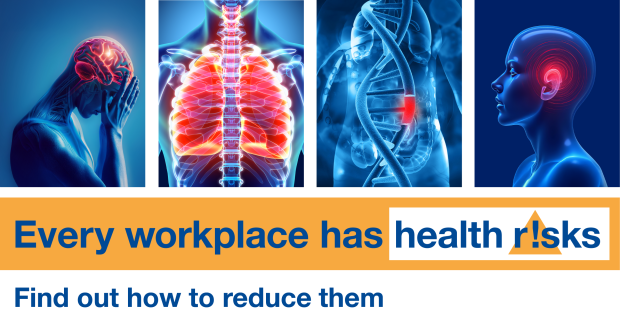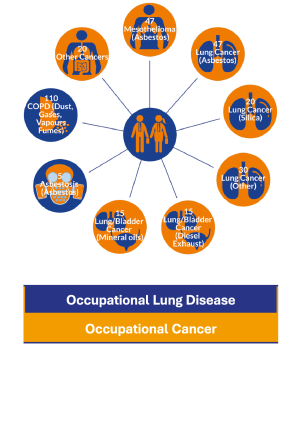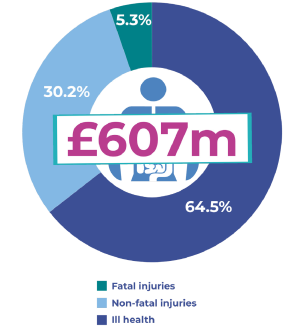
Introduction
Workplace health impacts every worker. Ill health caused or made worse by work can stay hidden for long periods and often manifests itself years later when the outcome, in many cases, is having to live with the consequences.
Workplace ill health is preventable. No one in Northern Ireland should develop ill health simply because of a job choice.
HSENI's Corporate Plan for 2023-2028 has identified three workplace ill health priorities, namely:
- occupational lung diseases
- occupational cancers
- work-related mental wellbeing and musculoskeletal disorders
Launched in April 2025, HSENI's Workplace Health campaign is aimed at driving the occupational health message home, raising awareness of the main workplace health concerns, the impact they can have, and the need for appropriate controls.
Every workplace has health risks - Find out how to reduce them.
For more specific information view our Workplace health topic pages listed below.
Overview of work-related ill health for Northern Ireland
Managing the risk to health in every profession is essential. Some of the most significant occupational health risks arise from exposure to common but harmful substances such as asbestos, silica, flour and other dusts, along with chemicals, gases and fumes that are present in many of our workplaces.
Poor management of health risks in the workplace ruins and costs lives.
Human cost - Average work-related illness deaths per year in Northern Ireland
Every year in Northern Ireland it is estimated that on average over 300 people die following exposure to substances because of a previous work activity, and thousands more are left living with serious and debilitating health conditions.
Occupational cancer - Average deaths per year:

- Mesothelioma (Asbestos) - 47
- Lung cancer (Asbestos) - 47
- Lung cancer (Silica) - 20
- Lung cancer (Other) - 30
- Lung / bladder cancer (Diesel exhaust) - 15
- Lung / bladder cancer (Mineral oils) - 15
- Other cancers - 20
Occupational lung disease - Average deaths per year:
- Asbestosis (Asbestos) - 5
- COPD (Dust gases, vapours, fumes) - 110
Other human cost
Whilst occupational cancers and respiratory diseases are all too common, not all work-related illnesses are fatal. Some can lead to employees living with debilitating conditions from exposure to hazardous substances, noise, and vibration, or due to unsuitable working arrangements.
There are several other conditions that can seriously affect our quality of life, including musculoskeletal disorders (MSDs) and mental ill health which can inhibit people from leading normal lives.
MSDs are a major cause of ill-health with an estimated 18,000 people in Northern Ireland suffering from conditions due to work affecting various parts of the body including the lower back, shoulders, neck, wrists and hands.
Mental ill-health, including work-related stress, can affect every one of us. Estimated figures suggest that 15,000 people in Northern Ireland suffered from stress, anxiety or depression, caused or made worse by work in 2023-24.
Managing the risk to health in every profession is essential. Some of the most significant occupational health risks arise from exposure to harmful substances such as asbestos, silica, flour and other dusts, along with chemicals, gases and fumes that are present in many of our workplaces.
Estimated financial cost of work-related injuries and ill health
Work-related ill health also comes with a price, with estimates indicating the cost to Northern Ireland society at over £391 million in 2022-23.

Fatal injuries - 5.3% (£32.17m)
Non-fatal injuries - 30.2% (£183.31m)
Ill health - 64.5% (£391.52m)
Estimates also suggest that in 2023-24, there were 640,000 days lost due to work-related ill health in Northern Ireland.
While financial costs to society can be estimated, the cost of human suffering as a result of suffering work related ill health is unquantifiable.
HSENI Workplace Health Statistics and Analysis booklet
HSENI has produced a 'Workplace health and analysis statistics booklet for Northern Ireland', illustrating the potential extent of workplace ill health in Northern Ireland.
This booklet can be viewed and downloaded at the following link:
Workplace Health Campaign Resources
HSENI is committed to providing simple, practical advice regarding work-related health matters to employers and employees.
As part of HSENI’s Workplace Health Campaign, 'Every workplace has health risks - Find out how to reduce them', the following resources have been designed to illustrate how health can be harmed by a lack of appropriate measures to control the risk at work.
The campaign resources will also and assist you in identifying the measures which need to be taken to protect your health, the health of your workers or colleagues, or others who may be affected by your work.
The measures also help protect the health of a business, by ensuring that employees remain in work and do not develop ill health as a result of a job that they are employed to do.
A series of workplace health topic pages is also included to give further practical information.
You can also Contact Us for further advice and guidance on any work related health queries.
Workplace Health Campaign Videos
View our Workplace Health Campaign videos relating to our three key workplace ill heath priorities below:
Occupational Lung Disease - Exposure to Dust
Musculoskeletal disorders (MSDs) - Manual Handling
Occupational Cancer - Exposure to Chemicals
Workplace Health Campaign Social Media Shorts
You can also watch the Workplace Health Campaign social media shorts at the following link on our website:
Workplace Health Campaign Posters
To view and download our Workplace Health Campaign posters relating to various occupational health topics and specific industry sectors, please see the link below:
Sector specific occupational health inspection proformas and resources
Below you will find occupational health inspection proformas and additional resources available for various industries:
All industries:
Construction:
Extractives, Mining, Quarrying and Waste:
Food Production:
Manufacturing:
Workplace health topic webpages

- Appointed doctors
- Asbestos
- Asthma
- Back pain
- Compressed air
- COPD
- COSHH (Chemicals)
- Display Screen Equipment
- Ergonomics
- Flour dust
- Hand Arm Vibration
- Health and medical surveillance
- Lead
- Legionella
- Lower Limb Disorders
- Manual handling
- Mental well-being at work
- Musculoskeletal Disorders
- Noise induced hearing loss
- Occupational cancers
- Occupational lung disease
- Silica dust
- Skin
- Upper Limb Disorders
- Welding fume
- Whole Body Vibration
Key legislation
- Health and Safety at Work (Northern Ireland) Order 1978 - (legislation.gov.uk)
- The Control of Noise at Work Regulations (Northern Ireland) 2006 - (legislation.gov.uk)
- Control of Substances Hazardous to Health Regulations (Northern Ireland) 2003 - (legislation.gov.uk)
- The Control of Vibration at Work Regulations (Northern Ireland) 2005 - (legislation.gov.uk)
- Management of Health and Safety at Work Regulations (Northern Ireland) 2000 - (legislation.gov.uk)
- The Construction (Design and Management) Regulations (Northern Ireland) 2016 - (legislation.gov.uk)
- The Control of Asbestos Regulations (Northern Ireland) 2012 - (legislation.gov.uk)
- Control of Lead at Work Regulations (Northern Ireland) 2003 - (legislation.gov.uk)
- The Manual Handling Operations Regulations (Northern Ireland) 1992 - (legislation.gov.uk)
- Workplace (Health, Safety and Welfare) Regulations (Northern Ireland) 1993 - (legislation.gov.uk)
- The Health and Safety (Display Screen Equipment) Regulations (Northern Ireland) 1992 - (legislation.gov.uk)